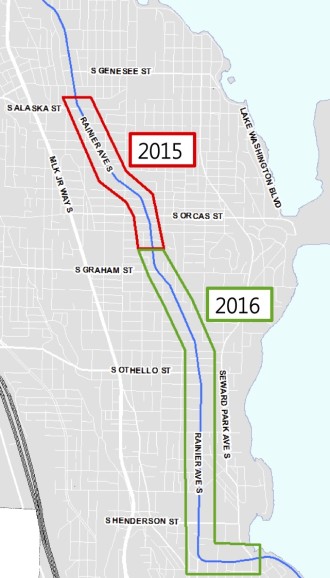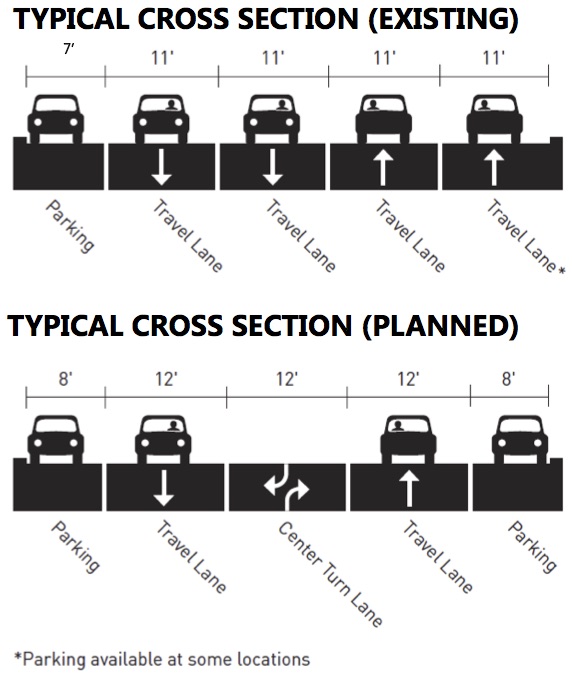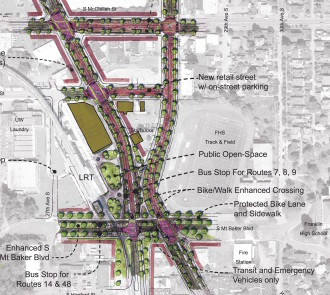 In an attempt to stop the flow of people from Rainier Ave to the emergency room, crews are finally out redesigning Seattle’s most dangerous street to be calmer, more efficient and more intuitive for everyone.
In an attempt to stop the flow of people from Rainier Ave to the emergency room, crews are finally out redesigning Seattle’s most dangerous street to be calmer, more efficient and more intuitive for everyone.
The changes were announced last week at a packed (and swelteringly hot) community open house (see this South Seattle Emerald story for coverage of that meeting).
And on Monday, just days later, crews were already out working to repaint the roadway and make other safety improvements.
It’s kind of hard to believe changes are really happening on Rainier. Though people have been asking for safety improvements for a long time, demands for real action always seemed to just bounce off City Hall. Rainier, it seemed, was just too big to fix. City leaders were either too scared to push for meaningful changes or they just didn’t care.
But that changed when neighbors got organized and got loud. With organizational leadership from Rainier Valley Greenways, Bike Works and Cascade Bicycle Club, the call for safe streets in Rainier Valley got far too loud to ignore. Councilmember Bruce Harrell — who is currently in a race for the city’s Council District 2 that includes Rainier Ave — made safety on the street a priority.
Mayor Ed Murray and his transportation team also took the job on through the city’s Road Safety Corridor program, which studies the city’s most dangerous streets and outlines immediate and long-term changes to improve safety. Those changes began Monday, with a pilot section (one mile from S Alaska St to S Kenny St) scheduled for completion by August 14.
Rainier avenue safety work progressing pic.twitter.com/guOO5hFM5d
— Dongho Chang (@dongho_chang) August 3, 2015
Hillman city. pic.twitter.com/TKdCAwINn3
— Dongho Chang (@dongho_chang) August 4, 2015
 Though ostensibly bike-focused groups (and this blog) played a significant role in helping to push for these changes, no bike lanes are planned in the near-term. But on-street parking was added. Yes, that’s right, biking and safe streets advocates helped add car parking to a street.
Though ostensibly bike-focused groups (and this blog) played a significant role in helping to push for these changes, no bike lanes are planned in the near-term. But on-street parking was added. Yes, that’s right, biking and safe streets advocates helped add car parking to a street.
In this case, car parking is a quick and easy way to narrow the effective road width, which helps calm traffic and prevent dangerous passing moves. And since this project is a pilot project enacted on a fairly short timeline, this is a huge step in the right direction that will prevent collisions and injuries.
Of course I’m disappointed that bike lanes are not going to be included in this phase of work, especially since there is no bike route alternative to Rainier (stay tuned for an update on the north-south Rainier Valley Neighborhood Greenway). One huge benefit of safe streets projects should be expanding transportation options for people who live, work or play in the area. A Rainier Ave with safe and comfortable bike lanes would transform affordable and healthy mobility in the area.
I’m also a little concerned about how wide the new lanes are. Studies have shown that wide lanes increase speeding and other dangerous behaviors. For example, will having 12-foot travel lanes and a 12-foot center turn lane lead to people passing dangerously in the “suicide lane?” I hope the city monitors this closely and is ready to make changes if they don’t see as big a safety improvement as they hoped.
Yet another benefit of bike lanes for people driving is that they help define and calm the road space, leading to fewer collisions and injuries for people in cars. Bike lanes are simply part of a complete street, and complete streets work better for everyone.
The city should outline a schedule for planning and funding quality bike lanes on Rainier. We can’t let them slip off into the “maybe some day” folder at City Hall.
But in the meantime, I’m just so ecstatic the city is finally taking serious action on Rainier Ave. Maybe once the excitement wear off, this will seem like a big missed opportunity. But right now, I just can’t allow the perfect to be the enemy of the OMG-the-city-is-actually-finally-doing-something-to-make-Rainier-safer.
For more details on the planned work, check out this presentation from last week’s open house (PDF).
Accessible Mt Baker moving forward (sort of)
 One bold plan to completely redesign the intersection of Rainier and MLK could also set the stage for quality bike lanes on both MLK and Rainier Ave through the entire Rainier Valley neighborhood. We have written about the Accessible Mount Baker project before, but it has since been earmarked for some funding in the Move Seattle levy (yet another reason to pass it!).
One bold plan to completely redesign the intersection of Rainier and MLK could also set the stage for quality bike lanes on both MLK and Rainier Ave through the entire Rainier Valley neighborhood. We have written about the Accessible Mount Baker project before, but it has since been earmarked for some funding in the Move Seattle levy (yet another reason to pass it!).
You can learn more about the evolving plan at an open house 6–8 p.m. October 1 at Kings Hall (2929 27th Ave S).








Comments
10 responses to “Right now, crews are making big fixes to Seattle’s most dangerous street”
I’m just going to throw this out there:
http://www.ravennablog.com/meet-your-new-and-improved-ne-75th-street-roadway-design/
The NE 75th St safety rework resulted in a 9ft turn lane, and 10.5ft travel lanes. NE 75th has buses. It handles 23k vehicles/day (similar to Rainier; south of Alaska, it appears to handle between 20k and 23k vehicles/day). Just like Rainier, it is not a designated freight route.
There are no buses on NE 75th between 25th and 35th Street NE which is half of the section that was modified.
Aside from the 68, the 995 travels on NE 75th as well and goes along the entire modified stretch.
Seattle is still on the wrong track, and I guess probably always will be. The more roads you build the more cars you will have. Why not join the 21st century like real cities? Eliminate pavement, increase mass transit, increase safe trails (not lanes) for cyclists and pedestrians. Seattle should be eliminating at least 50% of its paved areas, building trails and planting gardens. The car situation will only continue to worsen if you keep paving all the land. If you build it, they WILL come.
It’s a start and I suppose it is better than nothing.
No reason for the lanes to be that wide. If the whole point was to reduce speeds why provide a super-wide drag strip in both directions?
Also, I am far from thrilled to see them adding (!) parking. I’m sure it will be super easy to remove those parking spaces when we finally get around to re-striping this road correctly. Unthinkable that the familiar forces will rally to ‘save the parking’ and ‘war on cars, grumble, grumble.’ /s
Even with the extra parking a better distribution of space would be:
7′ Parking / 10.5′ Travel / 12′ Center Turning / 10.5′ Travel / 5′ Bike Lane (up-hill side only.) / 7′ Parking
A 5′ bike lane next to 7′ parking lane is 100% in the door zone and should be avoided for safety. It’s a configuration that increases driver hostility when safety-conscious people ride their bikes in the travel lane instead of the “perfectly good bike lane we just built for you” (see Reb Roush’s recent video).
NCHRP 766 puts the width of standard passenger vehicle door zones at 11 feet from the curb. Bicycle facilities should encourage cyclists to stay completely out of that area.
If they really insist on parking both sides, I’d prefer to ride on a street with:
8′ parking (reflecting the actual width of standard passenger vehicles)
3′ cross-hatched door zone buffer
10′ travel
10′ center turn lane
10′ travel
3′ cross-hatched door zone buffer
8′ parking
I’m not going to ride in a door zone bike lane if SDOT installs one, so why subject me to the extra harassment such lanes encourage?
I’m not surprised. Its still as if city planners assume everyone drives for transportation and bicycle is only for recreation purposes. Wake up city planners, a lot of young people in Seattle do not drive and some are not even pursuing a driver’s licence. More people are bicycle riding then ever. More traffic, more danger. Having all those people competing for parking spots is going to increase accidents. Please have common sense and instal cycle tracks, not widen the road and dramatically increase parking. Maybe if we hamer city design planers, Ed maury and jay inslee with our voices, more common sense modifications will happen and include bike safety.
Even without bike lanes the wider streets will allow bikes to ride in the “door” zone. Cars can still pass safely. Now the next step is to put the bike lane against the curb… but one step at a time.
[…] of corridor and spot improvements in Southeast Seattle, West Seattle, and Central […]